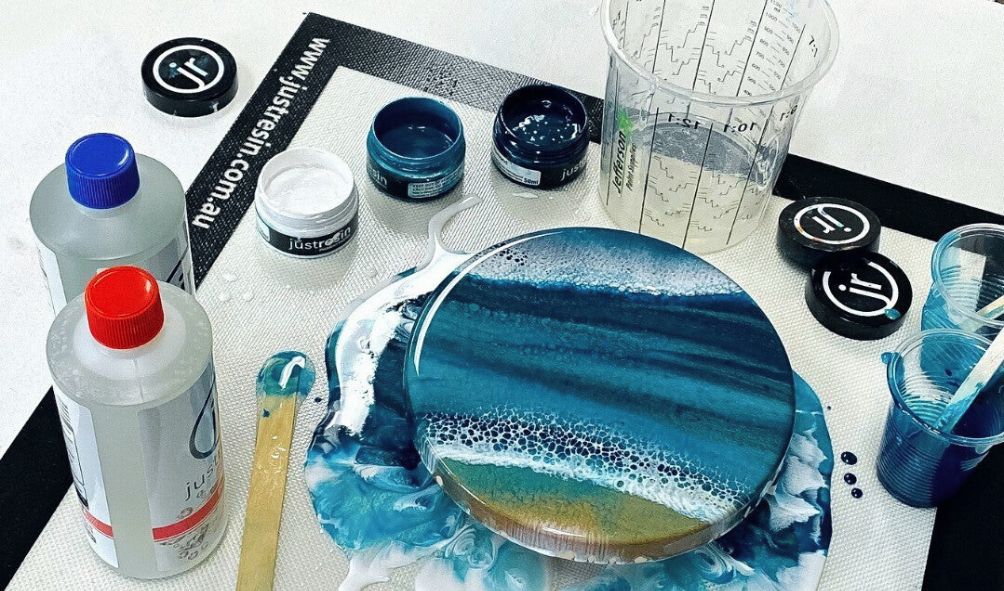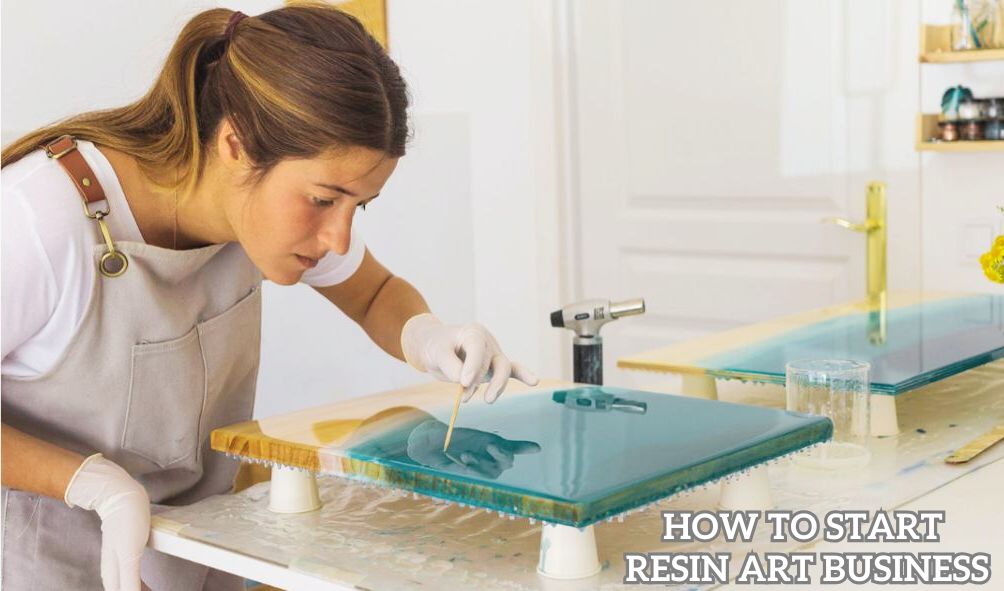Resin Art Business: The exciting world of resin art combines creativity and entrepreneurship. This article delves into the various components of starting and growing a successful resin art business, including market study, product development, marketing techniques, and financial preparation. We’ll look at current market trends, pinpoint important customer groups, and examine profitable pricing and marketing tactics used by well-known companies. Aspiring resin art business owners will have the information and resources they need to successfully negotiate the fascinating world of resin art thanks to this thorough insight.
This guide covers every crucial step involved in creating a successful resin art business, from creating original resin art goods and locating premium materials to creating a powerful web presence and efficiently handling your funds. We’re going to check out lots of online resin art business, talk about social media tricks that really work, and give you useful advice on how to handle customers and keep track of your products. The main goal is to help you turn your creative hobby into a business that actually lasts and makes money.
Market Research and Analysis
Understanding the resin art market is crucial for success. This section delves into current trends, consumer demographics, pricing strategies, marketing channels, and a comparison of various product niches within the resin art industry. This analysis provides a foundation for informed resin art business decisions.
Current Trends in the Resin Art Market
The resin art market is experiencing significant growth, driven by several key trends. The increasing popularity of DIY and crafting activities, fueled by social media platforms like Instagram and Pinterest, has significantly boosted demand. Furthermore, the desire for unique, handcrafted home decor and personalized accessories is a major contributing factor. Specific trends include the incorporation of natural elements like dried flowers and leaves, the use of vibrant and bold colors, and the exploration of abstract and geometric designs. The rise of eco-friendly resin options is also gaining traction, appealing to environmentally conscious consumers.
Key Demographics of Resin Art Consumers
The primary demographic for resin art consumers is broad, encompassing individuals across various age groups and socioeconomic backgrounds. However, a significant portion of the market consists of millennials and Gen Z, who are highly active on social media and appreciate unique, aesthetically pleasing items. Women represent a larger percentage of consumers, although male interest is also growing, particularly in areas like functional resin art, such as coasters or serving trays. Many consumers are also drawn to the therapeutic and creative aspects of resin art, leading to a growing number of individuals engaging in resin art as a hobby.
Pricing Strategies of Successful Resin Art Businesses
Successful resin art businesses employ diverse pricing strategies tailored to their target market and product offerings. Some resin art business utilize cost-plus pricing, calculating the cost of materials and labor and adding a markup for profit. Others employ value-based pricing, setting prices based on the perceived value of the product, often higher for unique or highly intricate pieces. Competitive pricing, matching or slightly undercutting competitors’ prices, is also a common strategy, particularly for businesses focusing on high-volume sales. Premium pricing, setting prices significantly higher than competitors to highlight exclusivity and superior quality, is often used for luxury or bespoke resin art.
Marketing Channels Used by Resin Art Businesses
Effective marketing is vital for resin art businesses. Social media platforms, particularly Instagram and Pinterest, are crucial for showcasing visually appealing products and reaching a broad audience. Etsy and other online marketplaces provide platforms for direct sales. Participating in craft fairs and markets allows for direct customer interaction and brand building. Collaborations with influencers and bloggers can increase brand visibility and reach a wider audience. Email marketing is effective for nurturing customer relationships and promoting new products or sales.
Comparison of Resin Art Product Niches
The following table compares four distinct resin art product niches:
| Product Niche | Profitability | Competition Level | Example Products |
|---|---|---|---|
| Jewelry | High (small material costs, high perceived value) | High (many sellers, saturated market) | Earrings, necklaces, pendants, bracelets |
| Home Decor | Medium to High (variable material costs, wide range of price points) | Medium (growing market, opportunity for niche specialization) | Coasters, trays, clocks, wall art |
| Functional Art | Medium (moderate material costs, functional aspect impacts pricing) | Medium (niche market, opportunity for innovation) | Serving trays, cutting boards, candle holders |
| Figurines & Sculptures | High (high skill required, unique designs command higher prices) | Low (niche market, high barrier to entry) | Animals, mythical creatures, abstract forms |
Product Development and Design
Developing unique and appealing resin art products is crucial for success in the online marketplace. This section outlines three distinct product concepts, detailing the materials, creation process, quality control measures, and potential suppliers. A strong emphasis on design and consistent quality will ensure customer satisfaction and brand loyalty.
Resin Art Product Concepts
Three unique resin art product concepts suitable for online sales are: 1) Coasters with embedded natural elements (dried flowers, leaves, etc.), 2) Geometric resin wall art featuring vibrant color combinations and metallic accents, and 3) Ornamental resin trays with embedded gemstones and metallic powders. Each product caters to a different aesthetic preference and price point, broadening market appeal.
Materials and Tools for Resin Art Production

The materials and tools required vary slightly depending on the chosen design, but generally include: Epoxy resin and hardener (specific ratios depend on the chosen brand), mixing cups and sticks, gloves and safety glasses (essential for handling resin), silicone molds (various shapes and sizes depending on the product), heat gun (for removing air bubbles), pigments (powders, liquids, or alcohol inks), additives (mica powders, glitter, etc.), embroidery floss, dried flowers, leaves, or other natural elements, gemstones, metallic powders, sandpaper, finishing sealant. Tools may include a digital scale for precise resin mixing, a craft knife, tweezers, and possibly a UV resin lamp (for certain types of resin).
Step-by-Step Guide: Creating Resin Coasters
1. Prepare the Workspace: Cover your work surface with newspaper or a silicone mat. Ensure good ventilation.
2. Prepare the Molds: Thoroughly clean and dry your silicone coaster molds.
3. Mix the Resin: Carefully measure and mix the resin and hardener according to the manufacturer’s instructions. Use a digital scale for precise measurements.
4. Add Pigments and Embellishments: Gently stir in your chosen pigments. Add dried flowers or other embellishments, ensuring they are evenly distributed within the mold.
5. Pour the Resin: Slowly pour the resin mixture into the molds, avoiding air bubbles.
6. Remove Air Bubbles: Use a heat gun to gently remove any trapped air bubbles. Work slowly and carefully to avoid overheating the resin.
7. Cure the Resin: Allow the resin to cure completely according to the manufacturer’s instructions. This typically takes 24-72 hours.
8. Demold and Finish: Once cured, gently remove the coasters from the molds. Sand any rough edges and apply a finishing sealant for added protection and shine.
Quality Control in Resin Art Production
Maintaining consistent quality is paramount. This involves: meticulous resin mixing (following the exact ratio specified by the manufacturer), thorough mold preparation to prevent defects, careful handling of resin to avoid air bubbles, proper curing time to ensure complete hardening, and consistent use of high-quality materials. Regular checks throughout the process will help identify and rectify potential issues before the final product is completed. Any inconsistencies in color, texture, or finish should be noted and addressed to maintain a high standard.
Potential Suppliers for Resin and Materials
Several online retailers and specialized craft stores supply resin and related materials. Examples include Amazon, Etsy, and dedicated resin supply websites. Local craft stores may also offer a range of products. Choosing reliable suppliers is vital to ensure consistent quality of materials and timely delivery. Researching supplier reviews and comparing prices is recommended to find the best option.
Business Operations and Management
Successfully launching and operating a resin art business requires a well-defined plan encompassing legal compliance, risk mitigation, efficient operations, and strategic marketing. This section details the key aspects of managing your resin art enterprise for sustainable growth.
Business Plan Development
A comprehensive resin art business plan is crucial for securing funding, guiding operations, and tracking progress. It should include an executive summary outlining your resin art business concept, target market, and financial projections. A detailed market analysis, encompassing competitor analysis and pricing strategies, is essential.
The plan should also specify your operational structure, including production processes, inventory management, and sales channels. Finally, a robust financial plan, including startup costs, projected revenue, and profit margins, should be included. A sample resin art business plan might project initial investment of $5,000 for supplies and equipment, with projected annual revenue of $20,000 in the first year, increasing to $50,000 in the third year, based on sales data from similar resin art business and anticipated market growth.
Legal Requirements
Establishing a legal resin art business entity is paramount. This involves registering your resin art business name, obtaining necessary licenses and permits (which vary by location), and understanding tax obligations. For example, you might need a resin art business license from your city or county, and potentially a sales tax permit depending on your location and sales volume. Compliance with relevant health and safety regulations regarding resin handling and product safety is also critical. Failure to comply with these regulations can result in fines or legal action. Consulting with a legal professional or small business advisor can ensure compliance with all applicable laws.
Potential Risks and Challenges
The resin art business faces various challenges. One major risk is the inherent variability in resin curing, which can lead to product defects. Another is competition from other resin artists, requiring consistent innovation and high-quality product differentiation. Seasonal demand fluctuations can also impact sales, necessitating flexible inventory management and diversified marketing strategies. Finally, managing supply chain disruptions, especially regarding resin and pigment availability, requires proactive sourcing and contingency planning. For example, a sudden increase in resin prices could significantly impact profitability unless alternative suppliers or cost-cutting measures are implemented.
Inventory and Order Fulfillment
Efficient inventory management is key to profitability. This involves accurately tracking stock levels, predicting demand, and minimizing waste. Implementing a robust order fulfillment system, whether through e-commerce platforms or direct sales, is equally important. This system should streamline the process from order placement to packaging and shipping, ensuring timely delivery and customer satisfaction. A well-organized workspace and efficient packaging materials can significantly improve fulfillment speed and reduce costs. For example, using pre-cut packaging inserts can reduce packaging time by 20% compared to cutting them individually.
Sample Marketing Calendar
A year-long marketing calendar should incorporate a mix of online and offline strategies.
| Month | Marketing Activities |
|---|---|
| January | Launch a new product line; promote winter-themed resin art on social media. |
| February | Valentine’s Day promotion; run a social media contest. |
| March | Collaborate with local businesses for cross-promotion; participate in a craft fair. |
| April | Spring cleaning promotion; focus on bright and cheerful designs. |
| May | Mother’s Day promotion; offer custom-made gifts. |
| June | Summer-themed designs; run a giveaway on Instagram. |
| July | Collaborate with influencers; offer discounts on bulk orders. |
| August | Back-to-school promotion; create educational resin art tutorials. |
| September | Fall-themed designs; offer workshops or classes. |
| October | Halloween promotion; create spooky resin art pieces. |
| November | Thanksgiving promotion; offer discounts and bundles. |
| December | Christmas promotion; offer gift sets and personalized ornaments. |
Sales and Marketing Strategies
A robust sales and marketing strategy is crucial for the success of any resin art business. This section outlines key strategies to effectively reach your target audience, build brand awareness, and drive sales. We will explore social media marketing, visual content creation, e-commerce platform selection, customer service, and pricing strategies.
Social Media Marketing Strategy for Resin Art

A well-defined social media strategy is paramount for reaching potential customers. This involves identifying the platforms most frequented by your target demographic (e.g., Instagram, Pinterest, Facebook) and creating a content calendar that mixes high-quality product photos, behind-the-scenes glimpses of the creative process, customer testimonials, and engaging stories. Consistent posting and interaction with followers are key to building a loyal online community. Utilizing relevant hashtags and engaging in collaborations with other artists or influencers can significantly broaden your reach. Paid advertising campaigns on platforms like Instagram and Facebook can also be effective in driving targeted traffic to your online store.
Engaging Visual Content for Social Media
High-quality visuals are essential for showcasing the beauty and uniqueness of resin art. Images should be professionally lit and sharply focused, highlighting the intricate details and vibrant colors of the pieces. For example, one image could feature a close-up shot of a resin coaster, emphasizing the swirling patterns and glossy finish. Another could showcase a larger piece, like a resin river table, in a stylish home setting, emphasizing its aesthetic appeal. Videos are also highly effective, showcasing the resin pouring process or time-lapse creation of a piece. Consider using short, dynamic videos with captivating music to increase engagement. Carousel posts on Instagram allow for showcasing multiple angles or variations of a single piece, maximizing visual impact.
E-commerce Platform Comparison for Resin Art
Several e-commerce platforms cater to artists and craftspeople. Etsy is a popular choice, known for its large audience of handmade goods enthusiasts. Shopify offers more customization and control over the online store’s design and functionality, but requires a greater technical understanding. Platforms like Amazon Handmade provide access to a vast customer base but often involve higher fees. The best platform depends on factors such as technical skills, budget, and desired level of control over branding and marketing. A comparison table could be created to analyze factors like transaction fees, ease of use, marketing tools, and customer support.
Importance of Customer Service in Building Loyalty

Exceptional customer service is vital for fostering customer loyalty and repeat resin art business. Prompt and personalized responses to inquiries, efficient order processing, and careful packaging to prevent damage during shipping are crucial. Addressing customer concerns with empathy and finding solutions to problems builds trust and positive word-of-mouth referrals. Offering personalized thank-you notes or small gifts with orders can also enhance the customer experience. Collecting customer feedback through surveys or reviews helps identify areas for improvement and demonstrates a commitment to customer satisfaction.
Effective Pricing Strategies for Maximizing Profitability
Pricing resin art requires a balance between profitability and market competitiveness. Consider the cost of materials, labor, time investment, and desired profit margin when setting prices. Analyzing competitor pricing can provide insights into market value. Offering tiered pricing based on size or complexity can cater to different budgets. Promotional pricing strategies, such as discounts for bulk orders or seasonal sales, can stimulate demand. Clearly communicating the value proposition of handmade, unique resin art justifies higher prices compared to mass-produced items. For example, a small resin keychain could be priced at $15, while a large, intricate resin table could be priced at $1500, reflecting the significant difference in material cost, labor, and complexity.
Financial Planning and Projections
A robust financial plan is crucial for the success of any new resin art business, and a resin art venture is no exception. Accurate financial projections provide a roadmap for navigating the early stages, securing funding, and making informed decisions about pricing, production, and marketing. This section outlines key financial aspects to consider when launching your resin art business.
Projected Income Statement for the First Year
The projected income statement forecasts revenue and expenses over the first year. It’s a vital tool for assessing profitability and identifying potential areas for improvement. A realistic projection considers factors like sales volume, pricing strategy, cost of goods sold (including resin, pigments, molds, etc.), and operating expenses (rent, utilities, marketing, etc.). For example, a resin art business projecting 100 pieces of art at an average selling price of $50 would have projected revenue of $5000. If the cost of goods sold per piece is $15, and operating expenses are $1000, the projected net income would be $3500 ($5000 – $1500 – $1000). This is a simplified example; a detailed statement would include more specific expense categories.
Cash Flow Projection for the First Year
A cash flow projection shows the anticipated inflow and outflow of cash over the year. This is distinct from the income statement, which focuses on accrual accounting. A cash flow projection is critical for managing working capital and ensuring you have enough funds to cover expenses as they arise. It accounts for timing differences between revenue recognition and cash collection, as well as expenses paid in advance or on credit. For instance, while the income statement might show revenue from a sale, the cash flow projection would only reflect the cash received after the customer pays. A significant discrepancy between income and cash flow can lead to cash shortages, so meticulous tracking is essential.
Potential Funding Sources for Starting a Resin Art Business
Several avenues exist for securing funding to launch your resin art business. These include personal savings, loans from family and friends, small business loans from banks or credit unions, crowdfunding platforms (like Kickstarter or GoFundMe), and even small business grants. The best option depends on your financial situation, the scale of your business, and your risk tolerance. For example, a small-scale operation might rely primarily on personal savings, while a larger venture might require a bank loan or crowdfunding.
Importance of Accurate Financial Record-Keeping
Maintaining meticulous financial records is paramount for the health and longevity of your resin art business. Accurate records are necessary for tax purposes, tracking profitability, securing loans, attracting investors, and making informed business decisions. Using accounting software or hiring a bookkeeper can streamline this process and ensure accuracy. Without accurate records, it becomes challenging to understand your business’s performance, identify areas needing improvement, and plan for future growth.
Summary
Launching and sustaining a successful Resin Art Business requires careful planning, creativity, and a dedication to quality. By understanding market trends, developing unique product offerings, implementing effective marketing strategies, and managing your finances responsibly, you can build a thriving enterprise that combines your artistic talents with entrepreneurial ambition. Remember that consistent effort, adaptation to market changes, and a focus on customer satisfaction are key to long-term success in this dynamic and rewarding field. This guide provides a solid foundation; your unique creativity and resin art business acumen will determine your ultimate success.
Read More:
- Best Drawing Tablets for Artists
- Sell Art Online and Make Money
- Creative Productivity Tools for Artists

